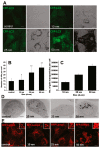Gold Nanoparticle-Induced Cell Death and Potential Applications in Nanomedicine
- PMID: 29518914
- PMCID: PMC5877615
- DOI: 10.3390/ijms19030754
Gold Nanoparticle-Induced Cell Death and Potential Applications in Nanomedicine
Abstract
Cell death is crucial to human health and is related to various serious diseases. Therefore, generation of new cell death regulators is urgently needed for disease treatment. Nanoparticles (NPs) are now routinely used in a variety of fields, including consumer products and medicine. Exhibiting stability and ease of decoration, gold nanoparticles (GNPs) could be used in diagnosis and disease treatment. Upon entering the human body, GNPs contact human cells in the blood, targeting organs and the immune system. This property results in the disturbance of cell function and even cell death. Therefore, GNPs may act as powerful cell death regulators. However, at present, we are far from establishing a structure-activity relationship between the physicochemical properties of GNPs and cell death, and predicting GNP-induced cell death. In this review, GNPs' size, shape, and surface properties are observed to play key roles in regulating various cell death modalities and related signaling pathways. These results could guide the design of GNPs for nanomedicine.
Keywords: apoptosis; autophagy; cell death; gold nanoparticles; necrosis; proliferation.
Conflict of interest statement
The authors declare no conflict of interest.
Figures



Similar articles
-
Overendocytosis of gold nanoparticles increases autophagy and apoptosis in hypoxic human renal proximal tubular cells.Int J Nanomedicine. 2014 Sep 12;9:4317-30. doi: 10.2147/IJN.S68685. eCollection 2014. Int J Nanomedicine. 2014. PMID: 25246788 Free PMC article.
-
Gold nanoparticle-conjugated nanomedicine: design, construction, and structure-efficacy relationship studies.J Mater Chem B. 2020 Jun 10;8(22):4813-4830. doi: 10.1039/c9tb02924a. J Mater Chem B. 2020. PMID: 32227036 Review.
-
Cytotoxicity of gold nanoparticles in human neural precursor cells and rat cerebral cortex.J Biosci Bioeng. 2016 Mar;121(3):341-4. doi: 10.1016/j.jbiosc.2015.07.004. Epub 2015 Aug 12. J Biosci Bioeng. 2016. PMID: 26277219
-
Gold Nanoparticles Conjugated with Glycopeptides for Lectin Detection and Imaging on Cell Surface.Protein Pept Lett. 2018;25(1):84-89. doi: 10.2174/0929866525666171218124434. Protein Pept Lett. 2018. PMID: 29256341
-
Advances in biodistribution of gold nanoparticles: the influence of size, surface charge, and route of administration.Biomed Mater. 2024 Jun 21;19(4). doi: 10.1088/1748-605X/ad5484. Biomed Mater. 2024. PMID: 38838693 Review.
Cited by
-
Gold Nanoparticles in Triple-Negative Breast Cancer Therapeutics.Curr Med Chem. 2023;30(3):316-334. doi: 10.2174/0929867328666210902141257. Curr Med Chem. 2023. PMID: 34477507 Review.
-
Galactose:PEGamine coated gold nanoparticles adhere to filopodia and cause extrinsic apoptosis.Nanoscale Adv. 2018 Nov 12;1(2):807-816. doi: 10.1039/c8na00270c. eCollection 2019 Feb 12. Nanoscale Adv. 2018. PMID: 36132240 Free PMC article.
-
Relative expression of microRNAs, apoptosis, and ultrastructure anomalies induced by gold nanoparticles in Trachyderma hispida (Coleoptera: Tenebrionidae).PLoS One. 2020 Nov 6;15(11):e0241837. doi: 10.1371/journal.pone.0241837. eCollection 2020. PLoS One. 2020. PMID: 33156883 Free PMC article.
-
Citric Juice-mediated Synthesis of Tellurium Nanoparticles with Antimicrobial and Anticancer Properties.Green Chem. 2019 May 21;21(8):1982-1988. doi: 10.1039/c9gc00131j. Epub 2019 Mar 11. Green Chem. 2019. PMID: 31156349 Free PMC article.
-
Functionalized Silica Star-Shaped Nanoparticles and Human Mesenchymal Stem Cells: An In Vitro Model.Nanomaterials (Basel). 2021 Mar 18;11(3):779. doi: 10.3390/nano11030779. Nanomaterials (Basel). 2021. PMID: 33803869 Free PMC article.
References
-
- Formigli L., Papucci L., Tani A., Schiavone N., Tempestini A., Orlandini G.E., Capaccioli S., Orlandini S.Z. Aponecrosis: Morphological and biochemical exploration of a syncretic process of cell death sharing apoptosis and necrosis. J. Cell. Physiol. 2000;182:41–49. doi: 10.1002/(SICI)1097-4652(200001)182:1<41::AID-JCP5>3.0.CO;2-7. - DOI - PubMed
Publication types
MeSH terms
Substances
LinkOut - more resources
Full Text Sources
Other Literature Sources

